I’m not a robot, takes up allot of my research time.
MyHeritage CEO Gilad Japhet Reveals Exciting New Developments During Keynote Talk
- By Esther


Founder and CEO of MyHeritage, Gilad Japhet, revealed some exciting new developments — some of which had never been made public before — during a talk he delivered online to the Israel Genealogy Research Association (IGRA) on June 23. While there are references in the first few minutes to Jewish historical records, the rest of the talk is not related to Jewish genealogy and describes MyHeritage’s latest features. Gilad also gives a sneak peek to exciting upcoming features that MyHeritage is currently developing in genealogy and DNA.
You can watch Gilad’s full talk in the video below:
Here are the highlights:
Historical record collections
So far this year, MyHeritage has added many new collections to our historical records, containing a staggering total of 1.2 billion records. Among those collections are some that were indexed by MyHeritage and are exclusive to the company, either in terms of content or in terms of searchability. Gilad highlighted the U.S. City Directories and the new Greek collections as examples.
Gilad added that there are many other exciting new collections the company is working on which he could not yet reveal.
Genealogy features
Next, Gilad introduced a soon-to-be-released redesign of MyHeritage’s historical record search engine. The new interface has the same versatile functionality as the previous one, but is more compact and user-friendly, and eliminates the need for separate “simple” and “advanced” search forms.
The form is slim enough that it will follow you while you’re looking at records, making it easy for you to fine-tune your search as you go. The form adapts its suggestions for new fields to fill in according to the context of the records you’re looking at.
Gilad also mentioned the recent automation of Cross-Language Record Matching, which makes it much easier to find records about your ancestors in other languages, and the introduction of the new Fan view for family trees — a new way to view your family tree that is particularly aesthetic and compact and can be shared as an image with family and friends.
He went on to describe an upcoming facelift to the traditional Family view: an updated design that will make more efficient use of the space, making it easier to see more information at once and reducing the need to scroll or drag the chart. There will be an additional option for square person cards that place the profile photo above the name of the person, making the view even more efficient in terms of use of space. The left-hand panel that offers an overview of a person’s profile will also get a facelift.
Another feature in the works is a handy relationship diagram that you’ll be able to access whenever you see a relationship description. The diagram makes it easy to visualize how two individuals are related, and you’ll be able to save it as a PDF image to share or to print. MyHeritage intends to add this feature to DNA Matches in the future as well.
Next, Gilad described the remarkable contributions MyHeritage has made recently to the world of genealogical photographs with the release of MyHeritage In Color™ in February, and the MyHeritage Photo Enhancer in June. Gilad pointed out that these features make MyHeritage the best platform for working with old family photos, and described the moving responses the company has received to the release of these features from users who got to see their ancestors in a whole new way.
DNA features
Finally, Gilad spoke about the much-anticipated update to MyHeritage’s Ethnicity Estimate: Genetic Groups. This update will provide a much higher-resolution breakdown of DNA ethnicity — possibly, Gilad says, the highest-resolution on the market, with 2,000–3,000 geographic regions at first and perhaps 5,000 in a future update.
Genetic groups will break the existing 42 ethnicities down into subgroups, including ethnic groups such as the Basques, the Sámi, and the Bretons, and even identifying groups that came from a particular city, such as Moroccan Jews from Casablanca. When the feature is released, every person who has taken a MyHeritage DNA test will be able to access this information for free.
Later, MyHeritage plans to add more valuable information that connects ethnicity to genealogy: common surnames from that region, common locations where that group is found, migration routes, and so on.
“The future of genealogy is bright”
Gilad concluded his talk by emphasizing MyHeritage’s continued commitment to genealogy. The company is at the cutting edge of advancements in genealogy and DNA, and Gilad promised that there are many more wonderful things in store. So stay tuned!








Audrey Stenhouse
June 26, 2020
How about using other languages e.g Sanskrit….Bengali etc.